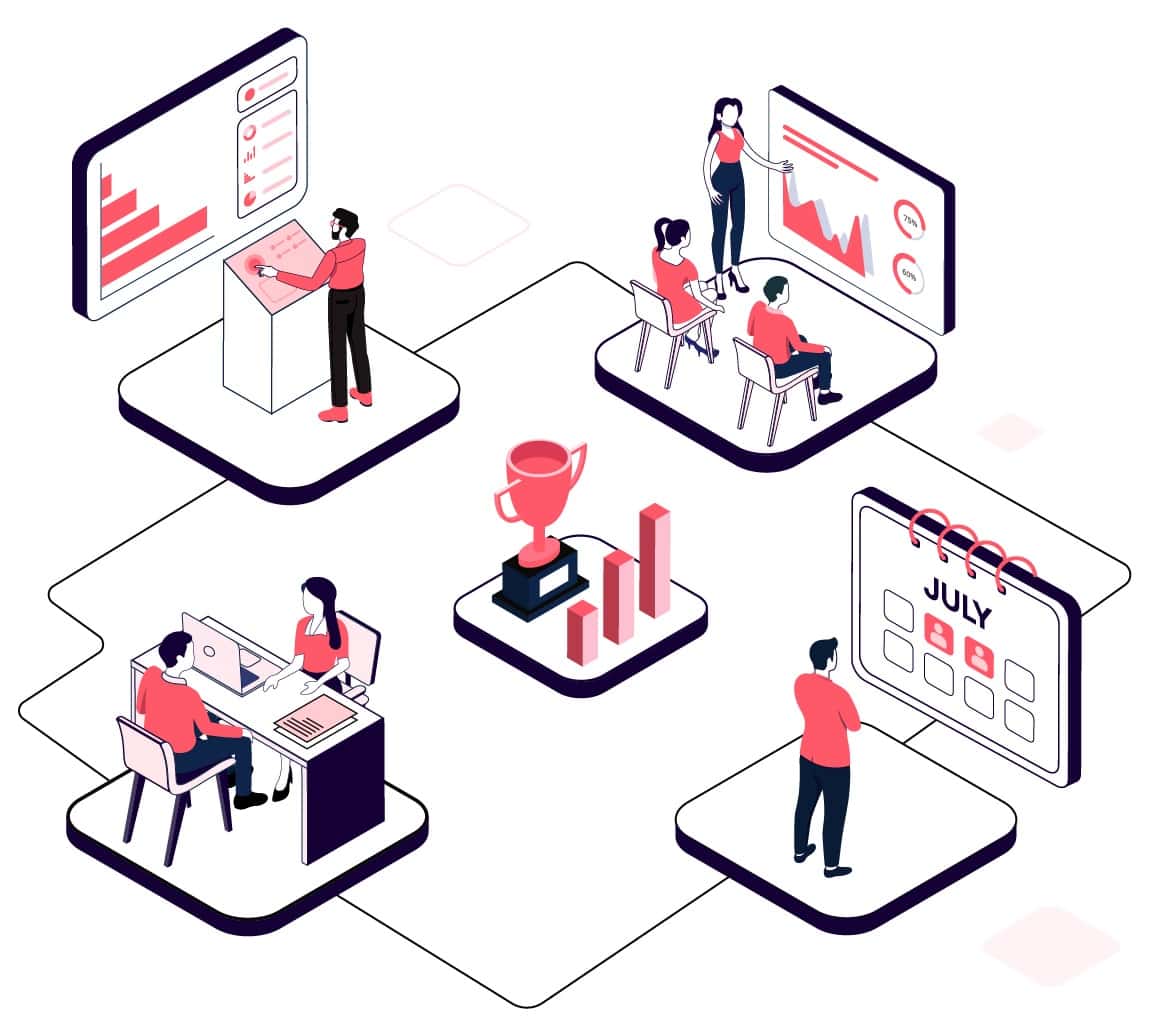According to a BARC research report, businesses using big data saw their profits increase by 8% while the costs were reduced by 10%. Big data and data analytics have been changing the way businesses operate.
Systematic analysis of your company performance can help you drive growth with data-backed decisions and enhanced operations. It works two-fold to increase productivity while decreasing the waste of resources.
In this guide, we take a deeper look at how you can drive growth at your company through the use of data by analyzing company performance at every step for optimized processes and superior results. Read on to learn more.

1. Focus on financial growth by picking the right KPIs
Keep financial growth and planning at the forefront of your data analysis to stay on the right path. Picking the right Key Performance Indicators (KPIs) helps you do so with ease. Use financial planning tools that help you set up and track relevant KPIs for targeted growth.
There are a plethora of KPIs you can use as benchmarks to gauge performance. But it’s important to pick the ones that will check the most important and targeted elements such as financial growth related to your business. Let’s take a look at this through an example:
If you are a SaaS company wanting to increase awareness about its brand, the KPI about the impressions your social media posts make will be beneficial to track. It helps you see many people see your post and engage with it.
But if your goal is to improve sales, the KPI about the impressions your social media posts get might not be the most relevant. This is because that particular KPI deals with the top-of-the-funnel content while your goal is about bottom-of-the-funnel engagement.
Here are a few tips to help you pick the most suitable KPIs:
- Pick a few targeted KPIs instead of a slew of them. Most will end up being irrelevant, confusing, and overwhelming you.
- Determine your long-term goal and short-term goals and associate KPIs with them.
- Pick KPIs that reflect both poor and good performance to have a balanced idea.
- Review your selected KPIs from time to time to see if they serve you or not.
2. Ace workforce management for increased productivity

A whopping 90% of businesses say that data and analytics are central in their plans going forward and for the transformation of their business. Analyzing every facet of your business will help you identify errors and opportunities alike to work on them.
One key factor companies should focus on first is managing their workforce correctly. Workforce management (WFM) refers to allocating employees and resources strategically to maximize performance and productivity.
Some of the key benefits of practicing WFM are:
- Improved productivity — The idea behind WFM is to match employees with tasks that best match their skill set and empower them with tools that help them perform said task efficiently. This helps employees perform more tasks within a given time frame with improved quality.
- Streamlined processes — WFM streamlines the processes performed in your company by coming up with the most optimized ways of performing the tasks through the use of data analysis. It identifies redundant steps and eliminates them.
- Decreased wastage of resources — When companies perform processes that are streamlined to only use resources that are necessary, it results in decreased wastage of resources.
You reduce the usage of resources and save costs of them, adding to your overall profitability. This point is highlighted in the statistic shared above from the BARC report. - Optimized workflows — Collectively, WFM works to create optimized workflows at every stage in an organization. It achieves this by letting employees know their exact role, and how to perform it, and supporting them with appropriate resources.
When people understand their roles and how to do them, there is a lesser chance of delays due to misinformation and errors. This helps in boosting the overall growth and performance of your company. - Positive work environment — An implicit benefit of having optimized workflows with WFM is the positive work environment it promotes. Employees know their role and how they’re supposed to perform it, relieving them of job-related stress.
Employees might even have healthy competition between them. They’d be able to achieve a better work-life balance while deriving greater satisfaction from their jobs. It only motivates them to perform even better.
There are many WFM tools available in the market. It’s important to choose the one that best suits your unique needs as an organization. Make sure to take into consideration your requirements, budget, and what you wish to achieve with your WFM.
Given below are the key features you should look for in a WFM tool:
- Bringing all departments under one roof for efficient management.
- Employee scheduling that takes employee preferences and project priorities into consideration to ensure flexible scheduling.
- Automation for daily tasks that require little human input such as document sorting and storing.
- Financial planning through the use of resource management, analytics, and automated reporting is performed by the platform itself.
- Providing valuable insights through targeted data analytics for variables such as delivery outcomes, time spent by employees on each task, and resource gaps that may occur.
3. Understand the customer journey to target them better

Data-driven companies are 23 times more likely to convert leads and 6 times more likely to retain customers. Data analytics helps you understand customers better and approach them with targeted messages.
When you understand your customer’s journey, you’re more likely to engage them with content and offerings that resonate with them. This is because you understand their pain points and can craft solutions for them.
Here are some of the best customer journey tools to help you make data-backed decisions in an inbound marketing approach to help customers find the right solutions for their problems. There are a few ways customer journey analysis helps you target them better:
- Segmentation — Conducting a thorough analysis of your target audience helps you segment them through various bases such as demographics, gender, region, culture, likes, dislikes, and preferences. This helps you target your advertising better by making sure it resonates with that segment.
- Understanding their pain points — By analyzing their buying patterns and preferences, you can identify their pain points to present tailor-made solutions to them. The rise of social media has allowed businesses to monitor and analyze customer behavior better.
- Where they stand in the sales funnel — Knowing how acquainted a customer is with your brands helps you engage with them in more meaningful ways. You can offer content and offers to them based on how much they know about you and how willing they will be to engage with it.
- How they respond to marketing efforts — Real-time insights into how your target audience reacts to your marketing efforts can tremendously help you shape your campaigns better and derive more engagement from them.
It will also help you reduce the wastage of resources by allocating them to things that get the most engagement from your audience. - Predictive analysis — Analysing customer patterns with different brands and products helps you gauge their next step with you. You’ll know just what to say to them to nudge them closer to making a purchase when you have a data-backed reference of their usual behavior.
4. Collect and organize data smartly for targeted results

Data collection is the foundation of the analytic approach of today. However, many small and medium-sized lack the funds and resources to conduct continuous and vast data collection operations at all times.
Even when they do, they often get overwhelmed with the vast amount of uncategorized data they have. They are unable to organize it in ways that will benefit them. While it’s advisable to be thorough with your data collection, there are still other options available that will allow you to use data collection to your aid without going too in-depth.
Simply collect data in a targeted manner. Collect data on variables that are important to your projects at the moment. This helps you tap into big data analytics to further your processes while putting exhaustive effort into it.
Collect data that is relevant to your goals and processes at the moment and organize it smartly for future use. While not as expansive as the continuous collection approach, this approach uses up fewer resources while giving you the benefits of data collection regardless.
It also helps you build a library over time of specific data sets that can aid further research in the future. It can even be more helpful at times as it will not overwhelm you with variables that might not be of use to you at the moment.
Analyze, optimize, and maximize business operations for success with data analytics
Big data and the Internet of Things have taken the world by storm as they offer unparalleled potential for businesses to optimize their operations for success. It’s important to educate yourself on how to make the most of data to reap its benefits.
Use analytics to optimize workforce management to improve workspace productivity. Analyze the customer journeys of your target audience to engage with them authentically. Pick the most relevant KPIs to pivot your efforts better. And lastly, collect and organize data smartly to get targeted results.
Let us know in the comments how you think data helps companies analyze their performances for growth.
Author bio
Atreyee Chowdhury is a professional content and copy writer with more than 10+ years of experience. She’s passionate about helping SMBs and enterprises achieve their content marketing goals with her carefully crafted and compelling content. She loves to read, travel, and experiment with different cuisines in her free time. You can follow her on LinkedIn.